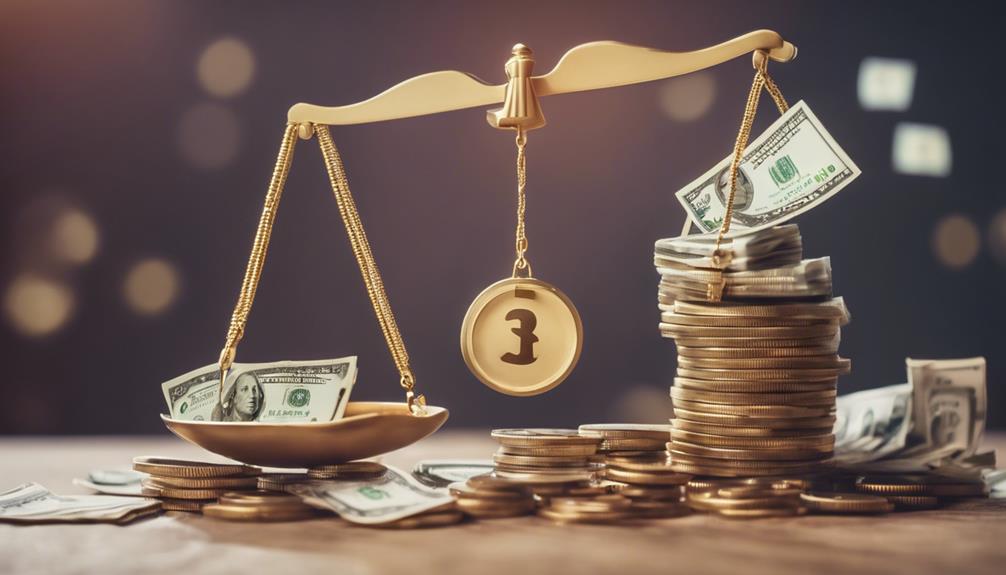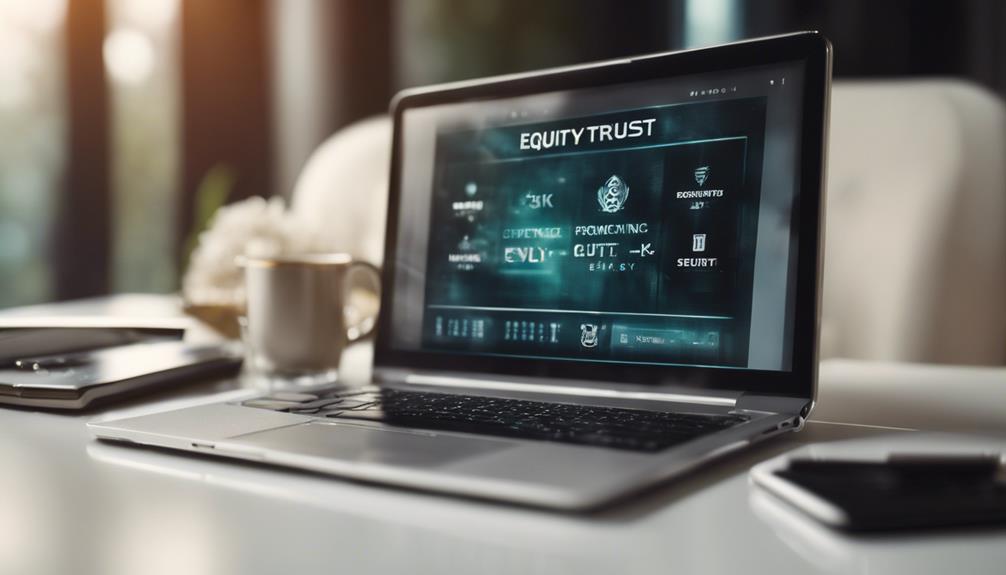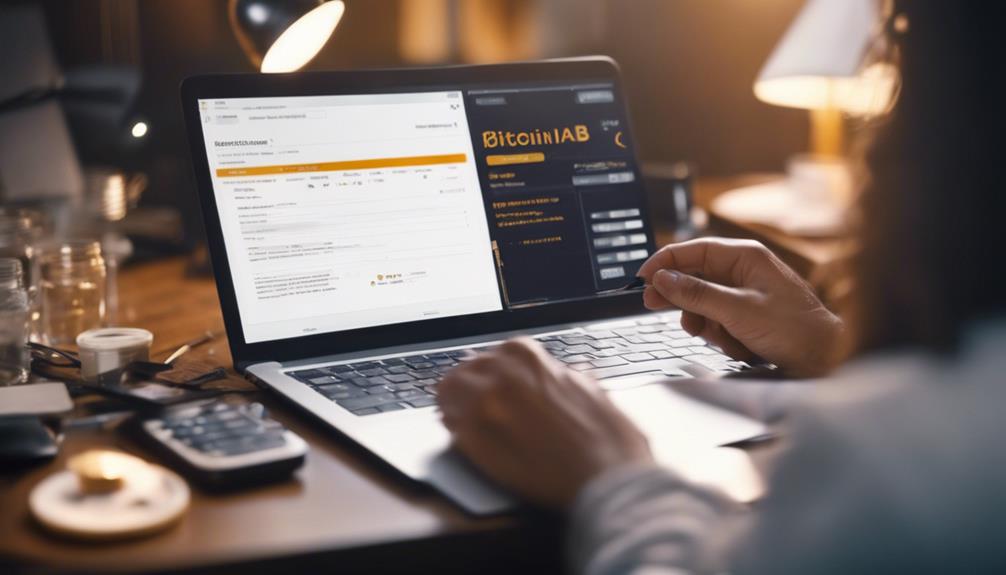IRA Investing
How Many Retirement Plans Should You Have?
Yearning for financial security in retirement? Discover the perfect number of retirement plans to optimize savings and tax advantages.

When planning for retirement, having multiple retirement plans can offer benefits such as diversifying investments and optimizing tax advantages. However, the optimal number of plans depends on individual goals and preferences. While multiple plans can maximize savings potential, managing them effectively requires careful attention to paperwork and administrative tasks. Balancing the advantages with potential drawbacks like increased complexity is essential. To determine the right number of retirement plans, consider factors such as investment diversification, tax benefits, and ongoing management requirements. Exploring various retirement plan options and seeking guidance from financial advisors can help tailor a strategy that aligns with your long-term financial goals.
Key Takeaways
- Consider having multiple retirement plans for diversification and tax advantages.
- Tailor the number of plans to individual financial goals and contribution limits.
- Evaluate administrative burdens and potential benefits of plan consolidation.
- Seek guidance from financial advisors to optimize retirement savings strategies.
- Regularly review and adjust retirement plans to align with changing circumstances.
Benefits of Having Multiple Retirement Plans

Why should individuals consider having multiple retirement plans for their financial future?
Having multiple retirement accounts offers a range of benefits that can enhance one's financial security during retirement. One key advantage is the ability to diversify investments across different accounts, reducing overall risk and potentially increasing returns. Additionally, different retirement plans come with unique tax advantages. For example, a 401(k) offers tax-deferred growth, while a Roth IRA allows for tax-free withdrawals.
Moreover, each type of retirement plan has its own contribution limits. By leveraging multiple accounts, individuals can maximize their savings potential and take advantage of tax benefits within those limits. This flexibility in contribution amounts also enables individuals to tailor their savings strategy to meet specific financial goals and retirement needs effectively. Additionally, having multiple retirement plans provides options for strategic income withdrawals in retirement, allowing individuals to minimize taxes and optimize their overall financial plan.
Drawbacks of Multiple Retirement Plans

Managing multiple retirement plans can lead to increased paperwork, administrative burdens, and potential confusion in tracking contributions and performance.
Additionally, monitoring investments across various accounts may become challenging, potentially resulting in suboptimal returns.
There is also a risk of incurring additional fees, such as maintenance or transfer fees, when juggling multiple retirement accounts.
Plan Consolidation Pros
Consolidating retirement plans offers numerous benefits, particularly in streamlining management tasks and reducing potential complexities associated with maintaining multiple accounts. Combining retirement accounts into a single consolidated plan can simplify paperwork, passwords, and administrative duties. This consolidation can help avoid confusion and frustration that may arise from managing various retirement accounts spread across different institutions. Additionally, it may lead to cost savings by eliminating duplicate fees and providing access to better investment options. Larger balances in a consolidated account might also waive low-balance fees that could be incurred across multiple accounts. This streamlined approach facilitates tracking investments, rebalancing portfolios, and overall financial management.
| Plan Consolidation Pros |
|---|
| Simplifies management tasks |
| Reduces paperwork and confusion |
| Potentially lowers costs |
Investment Diversification Benefits
Having multiple retirement plans can provide significant benefits through investment diversification across various assets and sectors. Diversification is key in spreading risk and potentially enhancing overall portfolio performance.
By utilizing different investment options within each retirement account, you can align your investments with your risk tolerance and financial objectives. However, managing multiple accounts and investments can present challenges in tracking and balancing your portfolio effectively.
It is important to carefully monitor your diversified retirement portfolio and make adjustments as needed to guarantee it remains in line with your goals. Regularly evaluating and rebalancing your investments across accounts can help maintain a diversified strategy that supports your long-term financial plans.
Administrative Complexity Risks
Dealing with the administrative intricacies associated with multiple retirement plans can pose significant challenges for individuals planning for their financial future. Managing contributions, investments, and monitoring activities across different accounts can lead to confusion and inefficiencies.
The varying rules, paperwork, and tax implications of each plan add to the complexity, making it overwhelming for some. Risks of errors like missing deadlines or duplicating investments are higher with multiple retirement accounts.
Coordinating withdrawals, required distributions, and beneficiary designations becomes more challenging when dealing with several plans. While diversifying retirement savings is essential, the administrative burden of juggling multiple accounts may outweigh the benefits for some individuals.
Consider consolidating or seeking professional guidance to streamline the management of your retirement plans and avoid potential pitfalls.
How Many Retirement Plans Are Ideal?

Determining the best number of retirement plans is a personalized decision that should align with your financial objectives and circumstances.
When considering how many retirement accounts to have, it's crucial to assess your savings, financial goals, and tax implications. While there is no set rule for the ideal number of accounts, some individuals find benefits in having multiple retirement plans. Diversification and potential tax advantages can be achieved by spreading savings across different accounts.
However, managing multiple accounts can add complexity. On the other hand, some may prefer the simplicity of optimizing their savings with just one retirement plan. Hence, the key is to strike a balance that aligns with your financial goals and preferences.
Managing Multiple Retirement Plans

When managing multiple retirement plans, consider the types of plans you have and whether consolidation could simplify management and reduce fees.
Seek guidance from a financial advisor to tailor a retirement savings strategy that aligns with your goals.
Stay informed about contribution limits and income thresholds for each plan to maximize your savings potential.
Types of Plans
Juggling multiple retirement plans necessitates a strategic approach to incorporate various account types effectively. Different retirement plans like 401(k), traditional IRA, Roth IRA, SEP IRA, or Simple IRA offer varying contribution limits, tax advantages, and eligibility criteria.
It is important to understand these differences to optimize your retirement savings. Monitoring and managing contribution limits for each account type individually is essential to avoid penalties or missed opportunities.
Regularly reviewing and adjusting your investment strategy ensures alignment with your financial goals. Seeking advice from a financial advisor can help create a personalized retirement savings plan that utilizes the benefits of different retirement account options.
Consolidation Tips
To efficiently streamline your retirement planning and optimize your financial strategy, consider consolidating multiple retirement plans. Consolidating your retirement accounts can simplify management, reduce administrative burdens, and potentially lower fees and costs, saving you money in the long run.
By merging your accounts, you can streamline tracking of investments and contributions, leading to better financial control. Additionally, having fewer accounts makes it easier to maintain a well-balanced and diversified investment portfolio. Avoiding overlap and improving efficiency are key benefits of consolidating retirement plans.
Take the time to assess your current retirement accounts, consider merging where beneficial, and optimize your overall retirement savings strategy for a more organized and effective approach to managing your investments.
Evaluating Retirement Plan Options

Considering the array of retirement plan options available, it is essential to carefully evaluate each based on your financial goals, risk tolerance, and tax implications.
When evaluating retirement plan options like IRAs and 401(k)s, it's important to take into account the tax benefits they offer. Traditional IRAs and 401(k) plans provide tax-deferred growth, meaning you won't pay taxes on contributions or earnings until you withdraw funds in retirement. On the other hand, Roth IRAs offer tax-free withdrawals on contributions and earnings in retirement, making them advantageous for those expecting to be in a higher tax bracket later on.
To maximize tax benefits and savings, it's advisable to have a mix of retirement plans. By diversifying your portfolio with a combination of 401(k), IRA, and Roth IRA accounts, you can take advantage of different tax treatments and withdrawal options. Evaluating contribution limits, employer contributions, investment choices, and withdrawal rules can help determine the most suitable number and types of retirement plans to have based on your individual circumstances.
Seeking guidance from a financial advisor can further assist in creating a personalized retirement plan strategy aligned with your long-term objectives and financial well-being.
Maximizing Retirement Savings Potential

In order to optimize your retirement savings potential, strategically diversifying your investment portfolio across multiple retirement accounts can be a prudent financial move. By spreading your investments across different types of retirement plans such as 401(k)s, IRAs, and Roth IRAs, you not only benefit from various tax advantages but also enhance diversification, which can help reduce risk and potentially increase returns over time.
Each retirement account offers unique features and benefits that can complement one another in a well-rounded retirement strategy. This approach allows you to tailor your savings to different goals, whether it's maximizing tax efficiency, seeking growth opportunities, or prioritizing flexibility in retirement income.
Balancing Your Retirement Portfolio

One key aspect of optimizing your retirement strategy involves strategically diversifying your investments across a range of retirement accounts. To effectively balance your retirement portfolio, consider incorporating different types of accounts such as a 401(k), traditional IRA, Roth IRA, SEP IRA, or Simple IRA. Each type of retirement account offers specific tax advantages and contribution limits, allowing you to diversify your savings while maximizing benefits.
By spreading your investments across various accounts, you can manage risk and optimize tax advantages based on your financial goals. Regularly reviewing and adjusting your retirement portfolio across these different accounts is essential to maintain a well-rounded and secure financial plan. Balancing multiple retirement plans enables you to save for retirement efficiently while taking advantage of the benefits offered by each account type.
This diversified approach can help you build a robust retirement portfolio tailored to your individual needs and circumstances.
Strategies for Retirement Plan Diversification

Implementing a well-thought-out strategy for diversifying your retirement plans is essential for optimizing your financial security in retirement. By having a mix of employer-sponsored plans such as 401(k)s and individual plans like IRAs, you can mitigate risk and take advantage of various tax diversification benefits. Having multiple retirement accounts also offers flexibility in withdrawal strategies during retirement, allowing you to manage your funds more effectively. Balancing pre-tax and after-tax retirement accounts is vital for optimizing tax strategies and ensuring you have options when it comes to taxes in retirement. When deciding on the number of retirement plans to have, evaluate your financial goals, risk tolerance, and retirement timeline to create a diversified portfolio that aligns with your needs. Consider the following table to understand the key aspects of diversifying your retirement plans:
| Retirement Plans | Benefits | Considerations |
|————————|—————————————-|————————-|
| Employer-Sponsored Plans | – Matching contributions
- Potentially lower fees
- Higher contribution limits | – Limited investment options
- Withdrawal restrictions |
| Individual Plans | – Greater investment choices
- Potential tax benefits
- More control over investments | – Lower contribution limits
- No employer match
- Possible fees |
| Withdrawal Strategies | – Flexibility in retirement income
- Tax efficiency
- Ability to adjust withdrawals based on needs | – Tax implications
- Early withdrawal penalties
- Long-term sustainability |
Reviewing and Adjusting Retirement Plans

How can you guarantee your retirement plans remain aligned with your financial objectives and risk tolerance over time? Regularly reviewing and adjusting your retirement plans is vital to ensure they stay in line with your evolving circumstances. Factors such as changing life circumstances, investment performance, and your retirement timeline should be considered when reviewing your plans. It's imperative to adjust your retirement plans as needed to accommodate market fluctuations, legislative changes, and personal financial situations.
Seeking guidance from a financial advisor or retirement planner can be invaluable in helping you evaluate and adjust your retirement plans effectively. These professionals can provide personalized recommendations based on your specific goals and risk tolerance. Staying informed about retirement planning strategies and tools is also important in optimizing your retirement savings and investments. By staying proactive and making necessary adjustments, you can better position yourself to achieve a secure and comfortable retirement.
Frequently Asked Questions
Is It a Good Idea to Have Multiple Retirement Accounts?
It is generally advisable to have multiple retirement accounts for the benefits they offer. Diversifying your accounts can provide tax advantages, investment flexibility, risk mitigation, and tailored savings strategies.
Should I Have a 401K and a Roth Ira?
Having both a 401(k) and a Roth IRA can offer significant benefits in retirement planning. A 401(k) provides pre-tax contributions and potential employer matching, while a Roth IRA allows for tax-free withdrawals in retirement. By combining these accounts, individuals can achieve tax diversification and better manage their tax implications in retirement.
Consider your financial goals, tax situation, and retirement income needs when deciding to have both a 401(k) and a Roth IRA.
How Many Accounts Should You Have for Retirement?
While there is no strict limit on the number of retirement accounts one can have, the decision should align with individual financial goals and circumstances. Multiple accounts can offer flexibility in savings strategies and tax benefits but require careful management.
Consider factors like contribution limits, diversification, and tax implications when determining the appropriate number of retirement accounts to support your long-term financial security.
Should I Combine My IRA and 401k?
Combining your IRA and 401(k) can streamline retirement savings management. This consolidation may lead to reduced fees and paperwork, offering a simpler approach to overseeing your retirement funds.
Having both types of accounts can enhance diversification in your investment portfolio. By merging accounts, you gain a clearer picture of your overall retirement strategy.
For personalized advice on merging your IRA and 401(k), consider consulting a financial advisor.
Conclusion
In the intricate tapestry of retirement planning, having multiple retirement plans can be likened to planting a variety of seeds in a garden.
By diversifying your investments across different accounts, you can guarantee a robust and resilient financial future.
Carefully managing and evaluating your retirement options, while aiming to maximize savings potential, will help you cultivate a bountiful harvest in your golden years.
Remember, a well-balanced and diversified portfolio is the key to reaping the rewards of a secure retirement.
Albert brings a wealth of knowledge and expertise to our writing team. With a background in caregiving and a deep understanding of the challenges faced by caregivers, Albert’s writing resonates with authenticity and empathy. He is committed to delivering high-quality content that empowers and supports caregivers on their journey.
IRA Investing
Top 5 Bitcoin IRA Custodian Services for Secure Retirement Investing
Tackle retirement investing with the top 5 Bitcoin IRA custodian services offering secure options and diverse cryptocurrencies.

For secure retirement investing with Bitcoin IRAs, these top custodian services stand out: Bitcoin IRA established in 2016 offering 60 cryptocurrencies with a $3,000 minimum start, plus $700 million insurance. BitIRA, founded in 2017, supports 15 cryptocurrencies, requires at least $5,000 investment, and stores keys in nuclear bunkers with thorough insurance. Equity Trust founded in 1974 supports 8 cryptos with no transaction fees but admin fees from $225 to $2,250. Coin IRA pioneers retirement account opportunities, with a $5,000 minimum investment and diverse options. iTrustcapital launched in 2018 offers 34 cryptocurrencies with a $1,000 minimum and enhanced security.
Key Takeaways
- Bitcoin IRA offers trading of 60 cryptocurrencies with $700 million insurance protection.
- BitIRA supports 15 cryptocurrencies with offline storage in nuclear bunkers.
- Equity Trust supports 8 cryptocurrencies with a $50 account setup fee.
- Coin IRA pioneers retirement investment options with a $5,000 account minimum.
- iTrustcapital offers access to 34 cryptocurrencies with no monthly fees and a $1,000 minimum investment.
Bitcoin IRA

Established in 2016, Bitcoin IRA provides a secure platform for trading 60 cryptocurrencies, offering investors a diverse range of digital assets for retirement portfolio diversification. With a minimum account start of $3,000 and $700 million insurance protection, Bitcoin IRA guarantees a safe environment for investors to explore the world of cryptocurrency. Security is paramount, with features like 256-bit SSL encryption safeguarding assets against potential threats.
Investors seeking to expand their retirement portfolios can take advantage of Bitcoin IRA's wide selection of cryptocurrencies. This variety allows for strategic investment choices, enhancing the potential for long-term growth and stability. By diversifying with digital assets through Bitcoin IRA, individuals can access a new universe of investment opportunities while prioritizing security and reliability.
BitIRA

Bitcoin IRA, a notable platform for cryptocurrency retirement investing, smoothly shifts to BitIRA, a custodian service offering secure storage solutions and a diverse range of digital assets for investors.
Established in 2017, BitIRA supports 15 cryptocurrencies, making it a versatile option for retirement investing. With a minimum investment requirement of $5,000, BitIRA prioritizes security by utilizing offline physical keys stored in nuclear bunkers to safeguard digital assets for retirement.
Additionally, the platform provides end-to-end insurance coverage, offering investors peace of mind regarding the safety of their investments. One of the standout features of BitIRA is its cost-effectiveness, as it does not charge any fees for its services, making it an attractive choice for those looking to invest in cryptocurrency for retirement.
Equity Trust

Providing a wide array of cryptocurrency investment options for retirement portfolios, Equity Trust stands as a reputable custodian service with a strong emphasis on security and financial growth. Established in 1974, Equity Trust supports 8 cryptocurrencies in Bitcoin IRAs, catering to investors looking to diversify their retirement holdings with digital assets.
While they charge a $50 account setup fee, their annual administration fees range from $225 to $2,250, without additional transaction fees, making them a cost-effective choice for managing Bitcoin IRAs. By focusing on both traditional and digital assets, Equity Trust offers a secure platform for retirement investing, ensuring that investors can safeguard their financial futures.
Additionally, investors can leverage Equity Trust's extensive experience and expertise in managing IRAs, benefiting from their insights for long-term financial growth. For those seeking a reliable custodian service to navigate the complexities of cryptocurrency investments within retirement accounts, Equity Trust presents a compelling option.
Coin IRA

With a focus on pioneering investment opportunities for retirement accounts, Coin IRA emerges as a trailblazer in the domain of cryptocurrency IRAs, offering a diverse range of investment options that go beyond traditional assets like precious metals. Coin IRA is one of the first companies to provide Bitcoin IRAs, enabling individuals to trade within and outside IRAs while also investing in precious metals. The account minimum for Coin IRA stands at $5,000, making it accessible to a broader range of investors. Additionally, the platform offered by Coin IRA is easy to use, with automatic trade options that simplify the investment process. Within IRAs, investors can choose from a variety of assets, providing flexibility and potential for growth in their retirement portfolios.
| Features | Details |
|---|---|
| Account Minimum | $5,000 |
| Investment Options | Bitcoin, Precious Metals |
| Trading | Inside and Outside IRAs |
| Automatic Trades | Available |
| Platform | Easy-to-Use |
Itrustcapital

iTrustcapital, a reputable Bitcoin IRA custodian service established in 2018, offers investors access to a wide array of 34 cryptocurrencies for retirement investing. With iTrustCapital, individuals can diversify their retirement portfolios by including digital assets alongside traditional investments.
One standout feature of iTrustCapital is the absence of monthly or setup fees for managing Bitcoin IRAs, making it a cost-effective option for investors. Additionally, the strategic partnership between iTrustCapital and Fortress Trust Company enhances the platform's security measures, ensuring that investors' assets are safeguarded.
For those interested in starting an account with iTrustCapital, the minimum account start is set at $1,000, making it accessible to a wide range of investors looking to explore the world of cryptocurrencies within their retirement savings.
Frequently Asked Questions
What Is the Safest Crypto Ira?
The safest crypto IRA custodian stands out for its robust security measures, including cold storage, multi-signature wallets, and insurance coverage. Assets stored offline in secure facilities protect against cyber threats.
Implementing encryption protocols and a strong track record of securely managing cryptocurrencies for retirement investing further enhance safety.
Prioritize custodians with a proven history of safeguarding digital assets to guarantee a secure and reliable investment for your retirement.
Is Bitcoin IRA a Good Company?
Bitcoin IRA is a reputable company known for its specialization in cryptocurrency IRA services. With over 60 supported cryptocurrencies and a minimum account start of $3,000, it offers a diverse investment portfolio accessible to various investors.
Backed by $700 million in insurance protection and robust security features like 256-bit SSL encryption, Bitcoin IRA prioritizes asset safety.
With a strong track record and positive customer reviews, it is considered a trusted choice for retirement investing in digital assets.
What Is the Minimum Deposit for a Bitcoin Ira?
The minimum deposit for a Bitcoin IRA can vary between providers, typically ranging from $1,000 to $5,000. It is important to check the specific requirements of each custodian before opening an account.
Higher minimum deposits, such as $5,000, may grant access to a wider selection of cryptocurrencies and additional account features. Understanding these deposit requirements is essential for individuals considering Bitcoin IRAs to plan their investment strategies effectively.
Which IRA Provider Is Best?
When considering the best IRA provider for retirement investing, it is essential to evaluate factors such as:
- Account minimums
- Investment options
- Customer reviews
- Fees
Each provider has its strengths and target audiences, so the best choice depends on individual preferences and financial goals.
Conduct thorough research, compare offerings, and consider consulting with a financial advisor to determine which IRA provider aligns best with your retirement investment strategy.
Conclusion
To summarize, when contemplating secure retirement investing, it is vital to choose a reputable bitcoin IRA custodian service. Options such as Bitcoin IRA, BitIRA, Equity Trust, Coin IRA, and iTrustCapital offer dependable solutions for those looking to diversify their retirement portfolio with cryptocurrency.
By selecting a trusted custodian, investors can guarantee the safety and security of their funds while taking advantage of the potential growth opportunities that Bitcoin and other digital assets provide. Keep your retirement savings secure with a reliable bitcoin IRA custodian service.
Albert brings a wealth of knowledge and expertise to our writing team. With a background in caregiving and a deep understanding of the challenges faced by caregivers, Albert’s writing resonates with authenticity and empathy. He is committed to delivering high-quality content that empowers and supports caregivers on their journey.
IRA Investing
How Does a Bitcoin IRA Work?
Hovering on the concept of Bitcoin IRAs, discover how they revolutionize retirement investing with cryptocurrencies, offering potential gains and tax advantages.

Bitcoin IRAs are self-directed retirement accounts allowing investment in cryptocurrencies like Bitcoin, Ethereum, and Litecoin. Managed by specialized custodians, they aim to diversify portfolios for potentially high returns. Benefits include diversification, potential gains, tax advantages in Roth accounts, and hedging against market fluctuations. Risks involve cryptocurrency volatility and additional costs. Tax implications include treating Bitcoin as property subject to capital gains tax. Custodians play an important role in secure management, and careful selection is advised. Opening a Bitcoin IRA involves selecting a compatible custodian, providing necessary information, considering fees, and making wise investment choices. Implementing robust security measures is crucial. Subtle complexities encourage further exploration.
Key Takeaways
- Bitcoin IRAs are self-directed retirement accounts that allow investing in cryptocurrencies like Bitcoin, Ethereum, and Litecoin.
- Specialized custodians manage these accounts, ensuring secure purchase and storage of digital assets.
- Investors can diversify their portfolios beyond traditional assets to potentially achieve high returns in the dynamic digital asset market.
- Tax advantages, especially in Roth accounts, can be leveraged to hedge against inflation and market fluctuations.
- Prudent risk management strategies are crucial due to the high volatility and lack of regulatory oversight in the cryptocurrency market.
Overview of Bitcoin IRAs

Bitcoin IRAs, a type of self-directed individual retirement account, provide investors with the ability to include cryptocurrencies such as Bitcoin, Ethereum, and Litecoin in their portfolios alongside traditional assets. These IRAs allow individuals to take control of their retirement savings and invest in digital currencies through specialized custodians.
By diversifying their portfolios with cryptocurrency, investors aim to potentially benefit from the high returns that this asset class can offer. However, it is essential to note that Bitcoin IRAs come with additional risks due to the volatility of cryptocurrency prices. Custodians play an important role in managing these accounts, ensuring the secure purchase and storage of digital assets.
Before deciding to open a Bitcoin IRA, investors should carefully assess the risks and costs associated with this investment strategy. By understanding the unique characteristics of Bitcoin IRAs, individuals can make informed decisions to align their retirement goals with their investment choices.
Benefits of Bitcoin IRAs

Cryptocurrency retirement accounts offer investors the opportunity to diversify their portfolios and potentially reap significant gains from the dynamic digital asset market.
Bitcoin IRAs enable investors to diversify their holdings beyond traditional assets by including cryptocurrencies like Bitcoin, Ethereum, Ripple, and Litecoin. The potential returns from Bitcoin IRAs are attractive due to the growth and volatility of the cryptocurrency market, offering a chance for substantial profits.
Additionally, there are tax advantages associated with Bitcoin IRAs, particularly in Roth accounts, where investors can benefit from tax-free growth and distributions, making them appealing for long-term investment strategies.
Furthermore, Bitcoin IRAs serve as a hedge against inflation and traditional market fluctuations, providing a level of security for retirement savings.
However, it is essential to take into account the risks involved, such as market volatility, security concerns, and the potential for hacking, requiring prudent risk management strategies to safeguard investments in this evolving financial landscape.
Risks Associated With Bitcoin IRAS

Investors considering alternative retirement investment options should be aware of the inherent risks associated with Bitcoin IRAs. One primary risk is the high volatility of cryptocurrencies, leading to significant price swings that can impact investment value.
Additionally, Bitcoin IRAs often come with extra costs like maintenance and holding fees, increasing the overall expenses for investors. Another concern is the lack of regulatory oversight in the cryptocurrency market, exposing Bitcoin IRA holders to potential risks.
During times of extreme volatility, third-party involvement in Bitcoin IRAs can affect liquidity and investment performance, further adding to the high risks involved. It is important for investors to carefully evaluate these risks before deciding to include Bitcoin IRAs in their retirement portfolio.
Tax Implications of Bitcoin IRAs

Within the domain of retirement investment options, the tax implications of including Bitcoin IRAs can greatly impact an individual's long-term financial strategy. When it comes to Bitcoin IRAs, the IRS taxes Bitcoin investments as property, subject to applicable capital gains taxes. This means that any gains realized from Bitcoin holdings within an IRA are taxed at capital gains rates.
One notable advantage of utilizing Roth IRAs for Bitcoin investments is the potential for tax-free growth and distributions, as Roth IRAs are funded with after-tax dollars. Additionally, there are annual contribution limits set by the IRS for cryptocurrency investments within IRAs, which investors should be mindful of to ensure compliance.
It is important to note that holdings in Bitcoin IRAs can typically only be liquidated during standard market hours, which may impact the flexibility of managing investments. Understanding these tax implications is vital for individuals looking to incorporate Bitcoin into their retirement portfolios effectively.
Custodians for Bitcoin IRAs

When considering custodians for Bitcoin IRAs, investors should prioritize aspects like:
- The custodian selection process
- Security measures in place
- The custodian's role in the transaction process
Selecting a reputable and secure custodian is vital for safeguarding cryptocurrency holdings within a Bitcoin IRA.
Understanding how custodians handle transactions and guarantee compliance with regulations is essential for the integrity and security of digital assets in a retirement account.
Custodian Selection Process
Careful consideration of a reliable custodian is essential when establishing a Bitcoin IRA to guarantee the secure management of cryptocurrency assets. When selecting a custodian for a Bitcoin IRA, investors should assess various factors such as fees, security measures, and reputation. IRA custodians, typically financial institutions, play an important role in managing the self-directed account and safeguarding cryptocurrencies held within it. These custodians provide platforms for secure buying, selling, and storage of digital assets.
Researching and comparing potential custodians is important to safeguard the safety and compliance of cryptocurrency investments within the IRA. By choosing a reputable custodian with robust security measures, investors can entrust their retirement funds to professionals who specialize in handling digital assets securely.
Security Measures in Place
When contemplating the security measures implemented by custodians for Bitcoin IRAs, offline storage solutions and stringent encryption protocols are crucial aspects in safeguarding investors' digital assets.
Custodians for Bitcoin IRAs guarantee 100% offline storage using segregated cold storage accounts, ensuring heightened security for investments. They also offer SSL secure trading with 256-bit encryption, making transactions safe and protected against cyber threats.
Digital wallets utilized by these custodians adhere to industry-leading security standards, adding an extra layer of protection to safeguard assets. By partnering with US-regulated entities, custodians guarantee that investors' funds are secure and compliant with regulations, offering peace of mind for those looking to invest in Bitcoin IRAs.
Role in Transaction Process
Custodians for Bitcoin IRAs play a pivotal role in facilitating the seamless execution of transactions involving the purchase, storage, and trading of cryptocurrencies within the IRA. These custodians ensure compliance with IRS rules, handle the secure storage of digital assets, and assist investors in managing administrative responsibilities related to their Bitcoin IRA. Choosing a reputable custodian is vital for the security and success of a Bitcoin IRA investment. Below is a table highlighting the key responsibilities of custodians for Bitcoin IRAs:
| Responsibilities | Description | Importance |
|---|---|---|
| Purchase of Cryptocurrencies | Facilitate buying various cryptocurrencies for the IRA | Essential |
| Secure Storage | Safely store digital assets to prevent loss or theft | Critical |
| Compliance with IRS Rules | Ensure adherence to IRS regulations for cryptocurrency investments | Mandatory |
Investment Options in Bitcoin IRAs

Investors utilizing Bitcoin IRAs have access to a diverse selection of cryptocurrency investment options, including Bitcoin, Ethereum, Ripple, Litecoin, and Bitcoin Cash. This allows individuals to diversify their portfolios within a single retirement account, spreading their investment across different cryptocurrencies.
By holding multiple virtual currencies, investors can potentially benefit from the growth opportunities presented by the cryptocurrency market while also managing the volatility associated with these assets. Custodians of Bitcoin IRAs play an essential role in facilitating the management and storage of these digital investments, ensuring they are securely held for retirement purposes.
The investment choices available in Bitcoin IRAs go beyond just Bitcoin, offering a range of options for individuals looking to explore the world of cryptocurrencies as part of their retirement planning.
Process of Opening a Bitcoin IRA

To establish a Bitcoin IRA, individuals need to select a custodian that permits cryptocurrency investments and provide necessary personal and financial information for account setup. It is important to make sure that the chosen custodian aligns with your financial goals and retirement objectives.
Comparing fees among different custodians is vital to avoid hindering progress toward your retirement plans. Conduct thorough custodian research to find the best fit for your Bitcoin IRA requirements.
When setting up the account, be prepared to provide personal details and banking information as part of the process. By carefully considering the account type, exchanges, and cryptocurrencies that best suit your needs, you can work towards building a solid financial foundation for your retirement.
Security Measures for Bitcoin IRAs

When considering security measures for Bitcoin IRAs, it is essential to prioritize secure storage solutions, like offline cold storage, to safeguard investments.
Additionally, encryption methods, such as SSL with 256-bit security, are vital for protecting trading transactions and personal data within Bitcoin IRAs.
Implementing multi-factor authentication adds an extra layer of security, ensuring only authorized access to cryptocurrency holdings.
Secure Storage Solutions
Secure storage solutions for Bitcoin IRAs implement stringent offline measures to safeguard investors' digital assets effectively. Here are three key components of these security measures:
- Offline Storage: Digital wallets in Bitcoin IRAs utilize offline storage methods to prevent online vulnerabilities.
- Leading Security Standards: Utilizing SSL secure trading and 256-bit encryption, custodians maintain high-level security for all transactions.
- Two-Factor Authentication: Adding an extra layer of protection, two-factor authentication is commonly used to secure access to Bitcoin IRA accounts.
Encryption for Protection
Utilizing advanced 256-bit encryption technology, Bitcoin IRAs guarantee robust protection for trading activities, prioritizing the security of investors' digital assets. Digital wallets within Bitcoin IRAs adhere to industry-leading security standards, ensuring data protection and safeguarding assets from potential threats.
Offline custody with segregated cold storage accounts further enhances security measures by keeping investments safe from online vulnerabilities. Two-factor authentication is implemented to provide enhanced account security and control over access.
Additionally, regular security audits and updates are conducted to uphold the integrity and safety of Bitcoin IRAs, maintaining a high level of protection for investors' assets. These measures collectively work to establish a secure environment for trading and managing digital assets within the Bitcoin IRA framework.
Multi-Factor Authentication
To fortify the security infrastructure of Bitcoin IRAs, the implementation of multi-factor authentication stands as a crucial measure in safeguarding investors' digital assets. This security measure adds an extra layer of protection by requiring multiple forms of verification, such as passwords, biometrics, security tokens, and SMS verification codes.
Future Outlook for Bitcoin IRAs

The increasing mainstream acceptance of Bitcoin IRAs reflects a growing recognition of the potential benefits they offer for retirement investment. As individuals seek to diversify their retirement savings, the allure of investing in the cryptocurrency market through a Bitcoin IRA has become increasingly appealing. The future outlook for Bitcoin IRAs appears promising, given the potential for significant returns in a market known for its volatility and growth. With more investors looking to incorporate digital assets into their retirement planning, Bitcoin IRAs are poised to play a more prominent role in diversifying portfolios.
Moreover, regulatory developments and the gradual acceptance of cryptocurrencies by institutional investors further bolster the future prospects of Bitcoin IRAs. As the cryptocurrency market continues to mature, Bitcoin IRAs are likely to become an integral component of retirement planning strategies, offering individuals a unique opportunity to capitalize on the evolving landscape of digital assets. Overall, the outlook for Bitcoin IRAs seems optimistic, signaling a shift towards embracing innovative investment options for retirement security.
Frequently Asked Questions
Is Bitcoinira Legitimate?
Yes, Bitcoin IRA is legitimate, with a solid reputation backed by over 170,000 users and numerous positive reviews. The company, headquartered in Los Angeles, offers secure self-trading options 24/7 and partners with BitGo for enhanced security.
Bitcoin IRA provides investment opportunities in popular cryptocurrencies like Bitcoin, Ethereum, Ripple, and Litecoin, empowering individuals to diversify their retirement savings. Trustworthy and reliable, Bitcoin IRA is a reputable choice for cryptocurrency investment within an IRA.
Can I Withdraw Bitcoin From Bitcoinira?
While Bitcoin IRA accounts do not allow direct withdrawals of Bitcoin, you can withdraw funds from your account in cash or transfer them to another IRA or retirement account.
Bitcoin IRA custodians manage the buying, selling, and storage of Bitcoin within the account.
Withdrawals from a Bitcoin IRA must adhere to IRS regulations and may be subject to taxes or penalties.
It is recommended to process withdrawals through the custodian to guarantee compliance with tax laws.
Do You Pay Taxes on Bitcoinira?
Yes, taxes are applicable on Bitcoin IRAs. Withdrawals from Bitcoin IRAs, whether traditional or Roth, are subject to taxation based on the type of account.
Traditional Bitcoin IRAs are taxed upon withdrawal, whereas Roth Bitcoin IRAs offer tax-free withdrawals due to contributions being made with after-tax dollars.
Understanding the tax implications of Bitcoin IRAs is essential for effective retirement planning to optimize benefits and minimize tax liabilities.
How Much Does It Cost to Set up a Bitcoinira?
Setting up a Bitcoin IRA typically incurs initial fees ranging from $1,000 to $3,000. Additional costs may include account maintenance and transaction fees, with some custodians charging an annual percentage of managed assets.
Total expenses vary based on the custodian, investment choices, and account size. Investors should carefully review fee structures and compare costs before establishing a Bitcoin IRA to guarantee ideal financial planning and investment management.
Conclusion
To sum up, when contemplating Bitcoin IRAs, it is crucial to weigh the potential benefits and risks, understand the tax implications, and select a reputable custodian.
By going through the steps of setting up a Bitcoin IRA and implementing security measures, individuals can confidently delve into this investment option for their future financial security.
The future prospects for Bitcoin IRAs remain promising, offering growth opportunities for astute investors.
Albert brings a wealth of knowledge and expertise to our writing team. With a background in caregiving and a deep understanding of the challenges faced by caregivers, Albert’s writing resonates with authenticity and empathy. He is committed to delivering high-quality content that empowers and supports caregivers on their journey.
IRA Investing
How to Maximize Bitcoin IRA Contribution Limits
Leverage IRS guidelines to increase Bitcoin IRA contributions beyond limits, securing a prosperous retirement strategy.

To maximize Bitcoin IRA contribution limits, consider IRS guidelines, such as the 2024 limit of $7,000 with catch-up contributions of $1,000 for those 50+. Utilize SEP or SIMPLE IRAs for self-employed individuals. Backdoor conversions and consolidation of accounts can bolster holdings. Enjoy tax advantages, reducing taxable income and deferring taxes on growth. Catch-up contributions for 50+ boost savings. Strategize for long-term wealth with consistent contributions and diversified assets. Leverage tax benefits for portfolio growth. Enhance retirement savings potential by consulting with a financial advisor. Enhance your future financial security by optimizing contributions aligned with your goals.
Key Takeaways
- Contribute up to $7,000 annually to Bitcoin IRA.
- Consider catch-up contributions of $1,000 for 50+.
- Utilize backdoor contributions for increased limits.
- Consult a financial advisor for optimization strategies.
- Regularly review and adjust contributions for growth.
Understanding IRS Contribution Guidelines

Understanding the IRS contribution guidelines is vital for effectively managing and maximizing contributions to your Bitcoin IRA. The IRS sets annual contribution limits for both traditional and Roth IRAs, with the 2024 limit being $7,000.
Individuals aged 50 and above have the option to make catch-up contributions of up to $1,000, allowing for a total contribution of $8,000 in 2024. It is important to note that these contribution limits are subject to inflation adjustments and may change annually.
To optimize your retirement savings account, it is essential to be familiar with the IRS guidelines governing Bitcoin IRAs. Consulting with a financial advisor can help ensure compliance with these rules and assist in strategically allocating contributions within the set limits.
Maximizing Annual Contribution Amounts

To effectively boost your Bitcoin IRA holdings, maximizing annual contribution amounts is key. Individuals can contribute up to $7,000 annually to a Traditional or Roth IRA to make the most of Bitcoin IRA contribution limits. For those aged 50 and above, catch-up contributions of up to an additional $1,000 are allowed, raising the total contribution to $8,000.
Self-employed individuals can consider utilizing SEP IRAs or SIMPLE IRAs to contribute up to $16,000 or $19,500, respectively, thereby maximizing retirement savings with Bitcoin. Exploring strategies like backdoor Roth conversions or consolidating old retirement accounts can also help increase Bitcoin holdings within IRA contribution limits.
Consulting with a financial advisor is advisable to optimize contributions and ensure compliance with IRS regulations when aiming to maximize Bitcoin holdings in an IRA. By strategically leveraging these options, individuals can work towards building a stronger financial foundation for their retirement.
Benefits of Tax-Advantaged Contributions

Contributing to a Bitcoin IRA with tax advantages can lead to significant long-term growth potential. These contributions provide tax benefits that can enhance investment returns over time.
Tax Savings Benefits
By leveraging tax-advantaged contributions to a Bitcoin IRA, investors can greatly reduce their current taxable income and potentially maximize long-term wealth accumulation. Contributions to a Bitcoin IRA are made with pre-tax dollars, leading to immediate tax savings.
Moreover, the earnings within a Bitcoin IRA grow tax-deferred, allowing for compounded growth over time. When it comes to retirement withdrawals, utilizing a Bitcoin IRA can result in being taxed at a lower rate compared to the working years. This tax-efficient strategy not only helps individuals maximize contributions but also aids in long-term wealth building.
Taking advantage of the tax benefits associated with a Bitcoin IRA can play a significant role in securing a financially stable retirement and optimizing overall wealth management.
Retirement Investment Advantages
Leveraging tax-advantaged contributions to a Bitcoin IRA offers investors a strategic pathway towards long-term financial security and wealth growth. By contributing to a Bitcoin IRA, individuals can benefit from significant long-term gains, as well as the added advantage of tax-free buying and selling of crypto assets within the account.
Additionally, withdrawals from a Bitcoin IRA at retirement age are tax-free, maximizing profits for the investor. This tax-efficient strategy not only allows for the elimination of taxes on selling crypto assets but also guarantees that investors can fully capitalize on their gains.
Investing in Bitcoin through a tax-advantaged IRA provides a reliable method for building wealth over time and securing a stable financial future during retirement.
Consideration for Catch-Up Contributions

Individuals aged 50 and over have the opportunity to make catch-up contributions to their retirement accounts, allowing for increased savings potential.
Knowing the eligibility criteria for catch-up contributions is essential for maximizing retirement funds efficiently.
Emphasizing the importance of catch-up contributions can greatly impact long-term financial security during retirement.
Age for Catch-Up Contributions
As investors reach the age of 50 and beyond, they are granted the opportunity to make catch-up contributions to their Bitcoin IRA accounts, offering a means to bolster their retirement savings beyond regular contribution limits. Catch-up contributions enable older investors to boost their retirement savings, maximizing the growth potential of their Bitcoin IRA as they near retirement age. For traditional and Roth IRAs, individuals aged 50 and older can contribute an additional $1,000. In comparison, those over 50 in a 401(k), 403(b), or most 457 plans have a catch-up limit of $7,500, allowing a total contribution of $30,500 when combined with the standard limit. Leveraging catch-up contributions is a strategic way to enhance retirement savings and secure financial stability in the future.
| Type | Age Requirement | Catch-Up Contribution Limit |
|---|---|---|
| Traditional IRA | 50 and older | $1,000 |
| Roth IRA | 50 and older | $1,000 |
| 401(k), 403(b), or most 457 plans | 50 and older | $7,500 |
Eligibility Criteria for Catch-Up
Upon turning 50, investors become eligible to make catch-up contributions to their Bitcoin IRA accounts, subject to specific criteria to enhance their retirement savings beyond standard limits.
Catch-up contributions are designed to help individuals aged 50 and above boost their retirement savings in traditional and Roth IRAs. For those eligible, the catch-up contribution limit is $1,000, increasing the total annual limit to $8,000 for older individuals.
Importance of Catch-Up
Boosting retirement savings immensely, catch-up contributions for individuals aged 50 and over in a Bitcoin IRA play an essential role in maximizing contributions and enhancing financial security for the future. In 2024, those eligible can contribute an additional $1,000, totaling $8,000, helping older investors optimize their retirement savings and Bitcoin holdings.
Catch-up contributions provide a valuable opportunity to make up for any shortfall in savings, offering a way to secure a more financially stable future. Understanding the significance of catch-up contributions is crucial for individuals looking to maximize their Bitcoin IRA and guarantee they are well-prepared for retirement.
Strategies for Long-Term Wealth-Building

Strategies for Long-Term Wealth-Building involve prudent financial planning and disciplined investment approaches to secure a stable financial future. To maximize long-term wealth within your existing Roth IRA, it is crucial to utilize the contribution limit fully.
Consider the catch-up contribution if you're 50 or above, adding an extra $1,000 to boost your retirement savings. Roth IRAs offer tax advantages for crypto investments, enabling tax-free withdrawals at retirement age.
Focus on consistent contributions over the long term to benefit from compounding growth and employ tax-efficient strategies within your Bitcoin IRA.
Diversification is key; consider including crypto assets in your IRA to potentially increase wealth accumulation and hedge against market fluctuations. By diversifying and staying committed to regular contributions, you can optimize your long-term wealth-building strategy and work towards a financially secure future.
Leveraging Tax Advantages for Growth

To maximize the growth potential of your investment portfolio, leverage the tax advantages offered by a Bitcoin IRA for tax-free growth. Here are some key points to ponder when planning and strategizing to make the most of these tax benefits and enhance your investment growth:
- Understand the tax advantages: Familiarize yourself with how a Bitcoin IRA can provide tax-free growth on your investments.
- Contribution limits: Be aware of the annual contribution limits set by the IRS for Bitcoin IRAs and aim to maximize your contributions within these limits.
- Tax-deferred growth: By contributing the maximum amount allowed to your Bitcoin IRA, you can benefit from tax-deferred or tax-free growth, potentially increasing your retirement savings significantly.
- Strategic planning: Develop a strategy to reach the contribution limits of your Bitcoin IRA over time, considering your financial goals and risk tolerance.
- Long-term investment growth: Utilize the tax advantages of a Bitcoin IRA to build a robust retirement savings plan that aligns with your investment objectives.
Enhancing Bitcoin IRA Contributions

Boosting the contribution limits of a Bitcoin IRA can greatly enhance your retirement savings potential. When considering maximizing your contributions, it's crucial to be mindful of the IRS limits for retirement accounts.
For 2024, the maximum contribution allowed is $23,000 for 401(k), 403(b), and most 457 plans. If you are aged 50 or older, you can take advantage of catch-up contributions, which allow for a total contribution of up to $30,500, providing an opportunity to further bolster your retirement savings.
Exploring the option of a Bitcoin IRA can offer the potential for significant growth while benefiting from tax-advantaged status. To make sure you are making the most of your Bitcoin IRA contributions, consulting with a financial advisor is recommended. They can help you strategize and optimize your contributions within the annual limits, aligning your retirement savings with your financial goals for a secure future.
Maximizing Potential Bitcoin Investments

For those looking to capitalize on the potential growth of Bitcoin investments, maximizing contributions to a Bitcoin IRA is a strategic approach to bolstering one's financial portfolio.
To make the most of your Bitcoin IRA and enhance your investment potential, consider the following:
- Utilize Catch-Up Contributions: If you are 50 or older, take advantage of catch-up contributions to increase your Bitcoin holdings within the IRA.
- Explore Backdoor Contributions: Look into strategies like backdoor contributions to further boost your Bitcoin investment potential.
- Regularly Review and Adjust: It's crucial to review and adjust your contributions regularly to maximize the benefits of the Bitcoin IRA contribution limits.
- Seek Advice from a Financial Advisor: Consulting a financial advisor can help you optimize your Bitcoin IRA contributions for long-term growth.
- Maximize Potential Growth: By implementing these strategies and seeking guidance, you can maximize the potential growth of your Bitcoin investments within your IRA.
Optimizing Retirement Savings With Bitcoin

Incorporating Bitcoin into retirement savings strategies can enhance long-term financial security and diversification. Maximizing Bitcoin IRA contribution limits, currently set at $7,000 for both Traditional and Roth IRAs in 2024, provides individuals with the opportunity to boost their retirement savings.
Additionally, those aged 50 and above can benefit from catch-up contributions, allowing an additional $1,000 for a total of $8,000 in IRA contributions for the year. By strategically allocating funds towards Bitcoin within their retirement portfolio, individuals can capitalize on the potential growth of cryptocurrency investments.
Understanding the rules and regulations governing IRA contributions is essential for making informed decisions and maximizing Bitcoin holdings within the contribution limits. Exploring different IRA providers that offer options for holding Bitcoin enables individuals to optimize their retirement savings strategy effectively.
Frequently Asked Questions
What Is the Limit for Bitcoin Ira?
The current contribution limit for a Bitcoin IRA, aligning with traditional IRAs, stands at $7,000 for 2024. Those aged 50 and above can make catch-up contributions of up to an additional $1,000, bringing the total allowable contribution to $8,000 annually.
How Do I Max Out My IRA Contribution?
To maximize your IRA contribution, analyze your financial situation, set a budget, and prioritize retirement savings.
Explore various IRA options, like Traditional, Roth, or SIMPLE IRAs, aligning with your goals. Consider catch-up contributions for those over 50.
Regularly review IRS updates on contribution limits. Utilize strategies like backdoor Roth contributions.
Consult with a financial advisor for personalized guidance on optimizing your retirement savings within annual limits.
Is It a Good Idea to Have a Bitcoin Ira?
Investing in a Bitcoin IRA can be a vital move for those intrigued by cryptocurrency's long-term potential. It provides the opportunity to diversify retirement portfolios and enjoy potential tax advantages.
However, due diligence is essential. Consult a tax advisor to comprehend the implications of a Bitcoin IRA fully. The decision should align with your risk tolerance and investment goals.
Evaluate the benefits against the risks before committing to a Bitcoin IRA.
How Do I Get Around My IRA Limits?
To address limitations on your IRA contributions, consider exploring strategies like:
- Utilizing a Backdoor Roth IRA conversion
- Maximizing contributions to employer-sponsored retirement plans such as a 401(k)
- Leveraging spousal IRAs if eligible
- Contributing to a Health Savings Account (HSA) for additional tax advantages
Consult with a financial advisor to evaluate advanced options like a Mega Backdoor Roth IRA for surpassing traditional contribution limits. Each approach can help optimize your retirement savings potential.
Conclusion
To sum up, maximizing Bitcoin IRA contributions can greatly enhance long-term wealth-building and retirement savings. By understanding IRS guidelines, leveraging tax advantages, and optimizing investments, individuals can secure a financially stable future.
Just as a skilled craftsman meticulously shapes a masterpiece, careful planning and strategic contributions can sculpt a secure financial future for retirement.
Albert brings a wealth of knowledge and expertise to our writing team. With a background in caregiving and a deep understanding of the challenges faced by caregivers, Albert’s writing resonates with authenticity and empathy. He is committed to delivering high-quality content that empowers and supports caregivers on their journey.
-

 Dementia Care2 months ago
Dementia Care2 months agoUnderstanding the Stages of Vascular Dementia: A Visual Chart Guide
-

 Dementia Care3 months ago
Dementia Care3 months ago10 Engaging Dementia Games for Cognitive Stimulation
-

 Dementia Care3 months ago
Dementia Care3 months agoHow Gabapentin Affects Dementia: A Comprehensive Guide
-

 Dementia Care3 months ago
Dementia Care3 months ago5 Things You Need to Know About Jack Nicholson’s Dementia
-

 Dementia Care1 month ago
Dementia Care1 month agoUnderstanding Narcissism and Dementia: A How-To Guide
-

 Dementia Care1 month ago
Dementia Care1 month agoHow to Deal with a Parent’s Dementia: A Practical Guide
-

 Dementia Care1 month ago
Dementia Care1 month agoDavid Suchet’s Wife Opens Up About Living with Dementia
-

 Dementia Care1 month ago
Dementia Care1 month agoUnderstanding the Link Between Ambien and Dementia: A How-To Guide




















